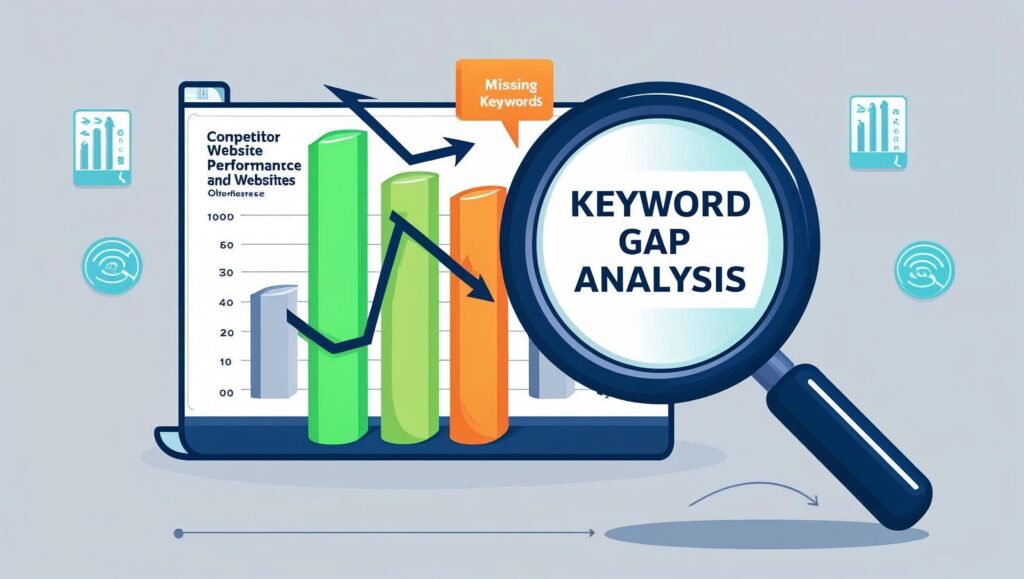Table of Contents
Well, in the ever-competitive digital landscape, ranking high on search engines is crucial for driving organic traffic. One powerful technique to boost your SEO strategy is conducting a keyword gap analysis. This process helps you uncover keyword gap opportunities and refine your content strategy to outperform competitors.
In this guide, we’ll break down keyword gap analysis, how it differs from content gap analysis, and how you can leverage both to optimize your website’s search engine performance.
What is Gap Analysis in Simple Words?
Gap analysis is a method used to compare the current state of something against a desired state. In marketing and SEO, it helps identify gaps between what you are currently achieving and what you could achieve with the right optimizations.
When applied to SEO, gap analysis is used to compare your website’s performance against competitors to find missing opportunities in keyword rankings and content strategy.
What is a Keyword Gap Analysis?
A keyword gap analysis is the process of identifying keywords that your competitors rank for, but you do not. These missing keywords present keyword gap opportunities that can help you create content or optimize existing pages to capture more organic traffic.
By finding and targeting these missing keywords, you can:
- Expand your search visibility
- Improve your competitive edge
- Drive more qualified traffic to your website
Benefits of Keyword Gap Analysis:
- Discover untapped keyword opportunities
- Enhance your existing content strategy
- Improve ranking potential by optimizing for missing keywords
What is Content Gap Analysis?
A content gap analysis focuses on identifying missing topics or subtopics in your content strategy. Unlike a keyword gap analysis that looks at ranking differences, a content gap analysis evaluates whether your content fully addresses user needs and search intent.
Examples of Content Gaps:
- Missing informational content (e.g., lacking how-to guides for certain topics)
- Missing transactional content (e.g., failing to include product comparisons or pricing pages)
- Incomplete buyer journey content (e.g., not addressing all customer pain points)
What is the Difference Between Keyword Gap and Content Gap?
| Feature | Keyword Gap Analysis | Content Gap Analysis |
| Focus | Keywords competitors rank for but you don’t | Missing topics or subtopics in content strategy |
| Goal | Improve search rankings by targeting new keywords | Create more valuable and comprehensive content |
| Key Metrics | Search volume, competition, ranking position | Content depth, relevance, engagement |
| Outcome | Higher organic traffic and keyword visibility | Better content relevance and audience engagement |
Keyword gap analysis finds keywords your competitors rank for but you don’t, while content gap analysis identifies missing topics in your content. Use tools like Ahrefs or SEMrush to uncover gaps, optimize existing content, and create new high-value content to boost rankings and traffic.
How to Do a Keyword Gap Analysis
To perform a keyword gap analysis, follow these steps:
1. Identify Your Competitors
Start by listing 3-5 main competitors in your niche. These should be websites ranking well for your target keywords.
2. Use SEO Tools for Keyword Comparison
You can use tools like:
- Ahrefs (Content Gap tool)
- SEMrush (Keyword Gap tool)
- Moz (Competitive Research tools)
- Google Search Console (for analyzing your existing keyword performance)
3. Analyze the Keyword Gaps
Check which keywords your competitors rank for but are missing from your website. Prioritize them based on:
- Search volume (higher is better)
- Keyword difficulty (lower is easier to rank for)
- Relevance to your business
4. Implement the Keywords
- Update existing content: Optimize blog posts and landing pages to include missing keywords.
- Create new content: If competitors are ranking for valuable keywords you don’t cover, create new pages or blog posts targeting them.
- Optimize on-page SEO: Ensure proper keyword placement in titles, meta descriptions, and headers.
How to Do a Content Gap Analysis
Performing a content gap analysis requires a deep dive into your existing content strategy to ensure it covers all relevant topics. Here’s how:
1. Define Your Content Goals
Determine what your audience needs and what gaps currently exist in your content.
2. Analyze Competitor Content
Use tools like SEMrush’s Topic Research, BuzzSumo, or Google’s “People Also Ask” to identify missing topics.
3. Identify Missing Content Types
Evaluate whether you lack blog posts, case studies, product guides, or FAQs that competitors provide.
4. Create a Content Plan
Based on your findings, create a content calendar addressing the missing topics. Ensure your content is well-researched and aligns with search intent.
What to Do with Keyword Gap Opportunities
Once you’ve identified keyword gap opportunities, take these actions:
- Prioritize the most valuable keywords based on competition and search volume.
- Update existing pages to include missing keywords naturally.
- Develop new content to target uncovered search queries.
- Track progress using tools like Google Analytics and Search Console to monitor ranking improvements.
Conclusion
Conducting a keyword gap analysis and content gap analysis can unlock massive SEO growth opportunities. By understanding the difference between the two and applying a strategic approach, you can improve your search rankings, attract more visitors, and stay ahead of the competition.
Start analyzing your gaps today and take action to optimize your website for long-term success!


